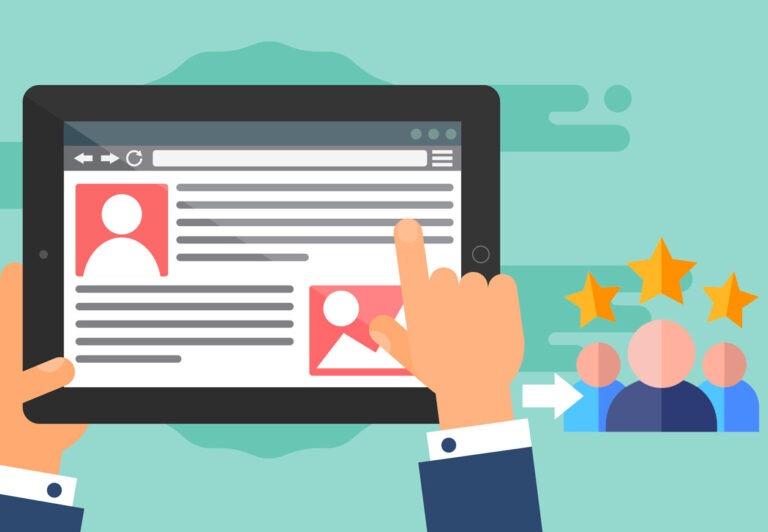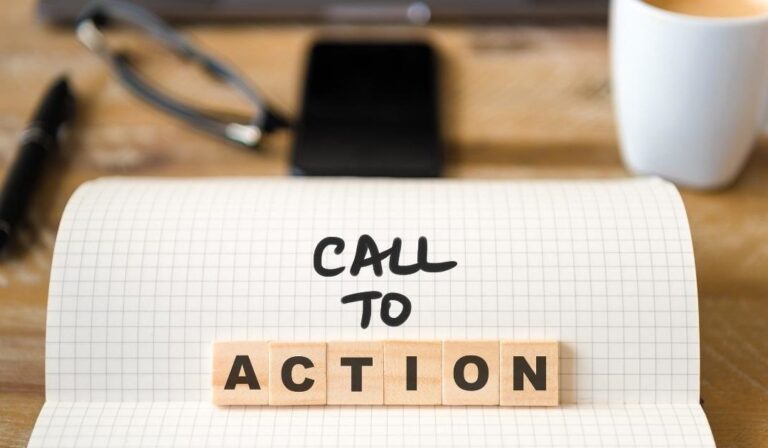Lead Generation: A Guide to Generate More Leads in 2025

I hope you enjoy this blog post. If you want Hello Bar to grow your leads, click here.
Author:
Ryan Bettencourt
Published
May 20, 2024

Effective lead generation is one of the cornerstones of a successful business. It helps you attract interested consumers to your products or services so you can convert them into customers.
At the top of the sales funnel, your customer hasn’t decided what or when to buy. This is the time to introduce yourself to prospects and show them what your brand is made of.
However, many businesses get lead generation wrong. According to HubSpot, 15% of marketers struggle with lead generation.
You don’t have to panic, though. We’ve put together 13 lead-generation hacks to help you gain more prospects and boost sales.
What is Lead Generation (or Lead-Gen Marketing)?
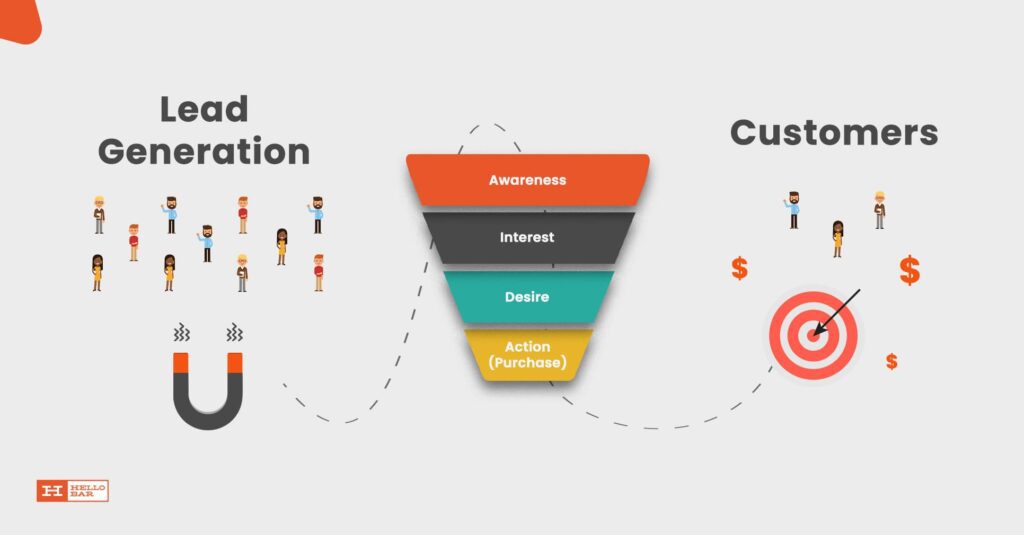
Lead generation refers to the practice of attracting consumers to your brand via numerous channels. You’re looking for consumers who fit your target audience and have the means and desire to buy what you sell.
In the old days, marketers hit the phones to generate leads. You can still do that, but the Internet has created faster alternatives.
Lead-gen marketing simply describes the process of filling the top of your sales funnel with leads and nurturing them to make a purchase. The more leads you collect — in particular, high-quality leads — the more sales you’re likely to make.
What Are the Best Lead-Generation Examples?
One excellent way to generate high-quality leads is to create an offer for your website visitors. With Hello Bar, you can create different popups and bars that communicate this offer to your visitors.
If people come to your website and see that you’re offering a 20-percent-off coupon, they’ll look for something to buy. We’re hard-wired to take advantage of sales, so it’s just good psychology.
Other great examples of strategies for generating leads include the following:
- Content marketing
- Social media marketing
- Paid search and paid social
- Retargeting ads
- Webinars
We’ll explore these in more detail later on in this article.
What Are the Best Tools for Lead Generation?
The best lead-generation strategies often start with automation. One effective way to achieve lead-generation automation is using business process automation (BPA) to streamline processes, reduce errors, and free up valuable time for marketers to focus on more important tasks, all while continuing to generate leads around the clock.
If you can collect leads while you sleep, meet with team members, or go out with friends, your business becomes infinitely stronger.
Hello Bar, for instance, allows you to not only capture leads with effective offers, but also to A/B test different offers. You’ll collect lots of data as you test different strategies, which will ultimately make your lead-generation campaigns more effective.
You’ll also want a well-respected email service. Such a service automatically collects lead information from web forms and allows you to send email autoresponders and other communications without lifting a finger.
What Is the Lead-Generation Process?
There’s no one right answer to this question because it varies from business to business. However, lead generation often follows a similar process regardless of your industry or audience.
- Consumers learn about your brand either organically or through your marketing efforts
- They get interested in what your brand has to offer and engage with your brand
- You use lead-capture forms to collect information about these prospects
Here’s a visual representing where lead generation fits into a sales funnel.
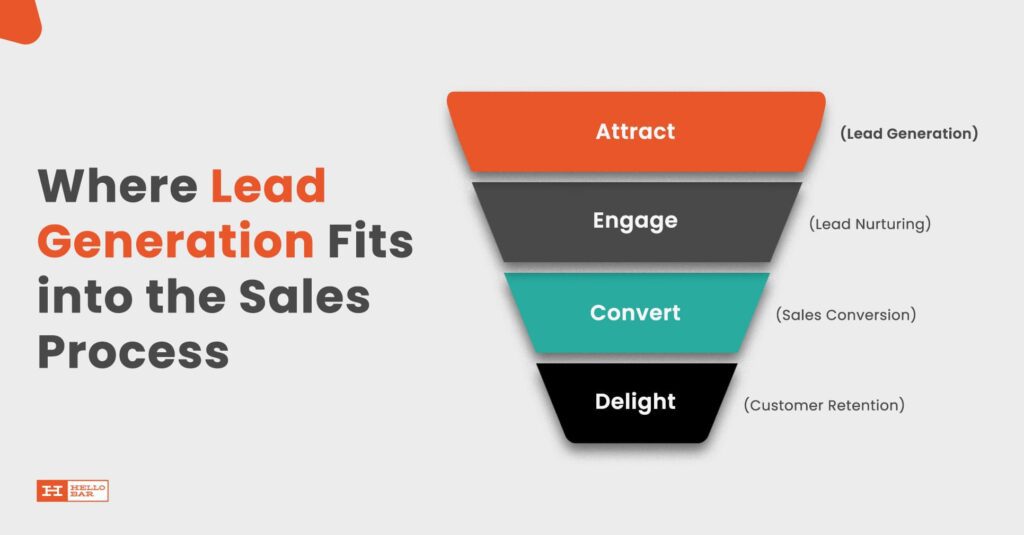
Here’s an explanation of the key stages in a sales funnel, as shown above:
- Attract potential customers through lead-generation tactics, such as content marketing.
- Engage your audience through email marketing, social media marketing, and other efforts.
- Convert prospects into customers by presenting them with irresistible offers.
- Delight returning customers with continued offers and good customer service.
Each stage in this process should be carefully crafted for your specific audience. For instance, some businesses might have more luck with content marketing than social media marketing. That’s okay. Go with your strengths and your prospects’ behaviors.
13 Proven Hacks for Massive Lead Generation
Now that we’ve covered the background details, it’s time to look at the best strategies for lead generation. You can use all of them or pick a few with which to start.
Just keep in mind that lead generation can vary depending on your audience. You might find that one hack boosts your leads by 300 percent and another doesn’t make a dent.
If you’re constantly testing lead-generation strategies and new methods, though, you’ll find the ideal combination. Marketing will get infinitely easier because you’ll know how to reach and attract your target audience.
1. Create High-Quality Content
Content marketing is one of the most effective lead-generation strategies. Prospects can find your content via search engines, engage with your website, and then discover what you sell.
The best content solves a specific problem. It hits on a customer’s pain point, describes a process or solution, and offers something memorable to take away. Once you’re done withe the draft, read and read it again and paraphrase some parts, as needed, to make them easier to understand. The best content hits on a customer’s pain point, describes a process or solution, and offers something memorable to take away.
Let’s say you run a footwear e-commerce store. You could write about topics like running and other fitness activities, selecting appropriate shoes, and coordinating outfits.
CAT Footwear, for instance, has an active blog—Shoe Advisor—on its website where users can find tons of useful information about footwear.
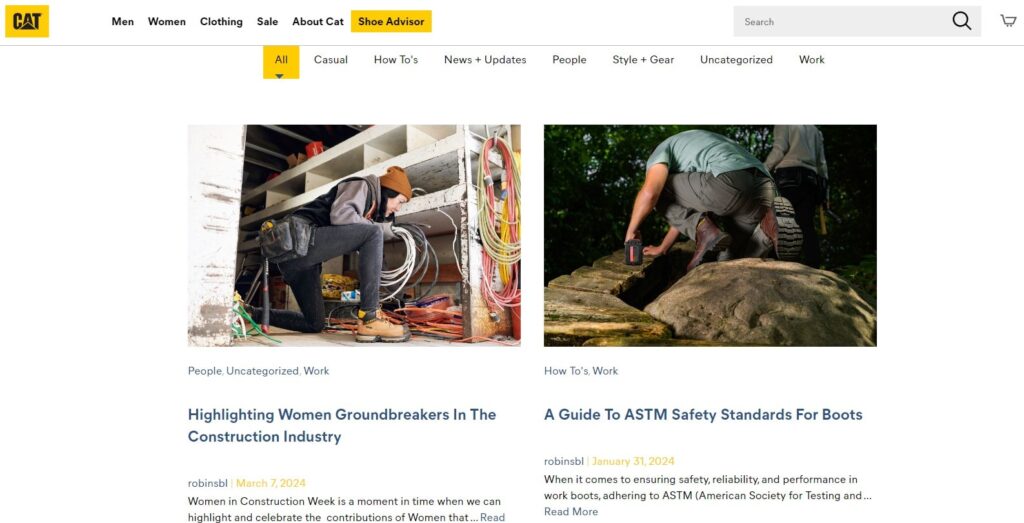
Image via CAT Footwear
Of course, text isn’t the only effective type of content. You can also publish podcasts, videos, infographics, and other types of content to expand your audience further. If you want to make your content more engaging, consider creating it in an interactive form, such as a flip book
2. Optimize Your Website for Lead Generation and Conversions
An unoptimized website doesn’t do you or your visitors any favors. You need to continually revamp your lead-generation offers, so pay careful attention to every page.
Optimization can seem a bit daunting, especially if you have a site with hundreds or thousands of pages. Deploying a site-wide lead-generation solution like Hello Bar can prove extremely efficient. You can still adjust the offer on individual pages based on their content.
Remember that the word “conversion” has different meanings depending on your goal. For lead generation, you want the prospect to call your business, hand over an email address, follow you on social media, or otherwise get in contact with your company.
In other words, your goal isn’t to make a sale but to tip visitors to the top of the funnel.
Make Your Message as Clear and Simple as Possible
Today’s consumers are busy and impatient. They won’t waste time trying to decode a confusing offer or follow a ton of steps to reach a goal.
Your lead-generation message or offer should prove both compelling and easy to follow. For instance, let’s say you want people to sign up for your email newsletter using a lead magnet.
Log into your Hello Bar account, click on the Manage tab on the left-hand navigation bar, and select “Collect Email” from the list of choices.

You can then customize your Hello Bar however you’d like, from the aesthetic styling and success message to the cookie duration and the type of device on which you want it to show.

You can change every element individually. For instance, “Click Here” might not work for your CTA. You could change it to “Get My Free List” or “Yes, I Want My List.”
A/B testing different CTAs and offers can help you maximize lead generation and conversions. Don’t assume that you’ll nail it on the first try.
Once you deploy the Hello Bar, visitors can join your mailing list from any page on which you’ve published it. Including a compelling lead magnet can make your offer more enticing.
Add Obvious and Compelling CTAs
The CTA matters more than any other element of a lead-generation campaign. If you don’t tell your visitors exactly what you want them to do, they probably won’t do anything at all.
You’ll notice that, in the above example, we used a declarative statement for our Hello Bar: “Download your free lead-generation checklist now!”
There’s a reason for that. Instead of asking a rhetorical question, give a command. You might increase your conversion rates by making this simple change.
Use A/B Testing to Experiment With CTAs and Other Elements
It’s impossible to know exactly what offer or message will work best for your specific audience. At least, not until you test it.
A/B testing is one of Hello Bar’s unique, built-in functions. You can create two or more versions of your popups with slightly different CTAs or other elements. Hello Bar will automatically show one version to some site visitors and the second to others.
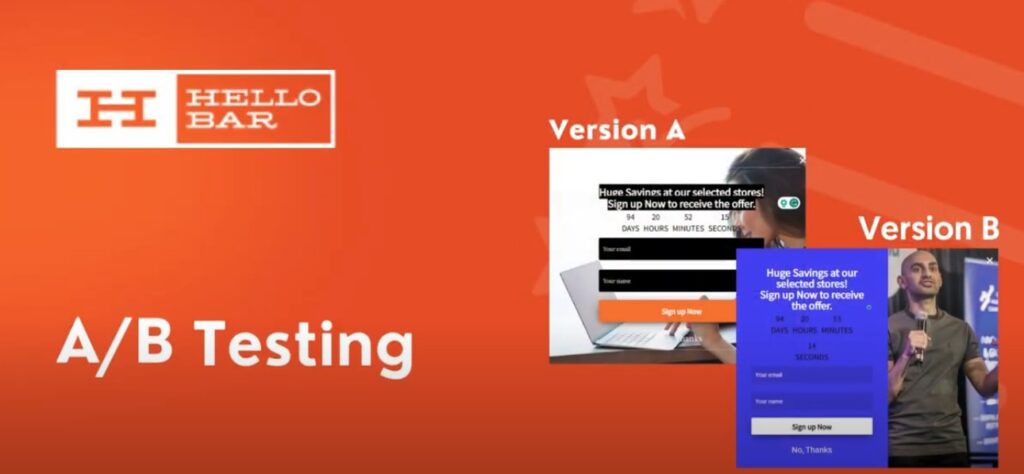
Image via Hello Bar
Depending on which version gets more clicks and conversions, you can identify the best elements to use in your lead-generation forms and popups.
With Hello Bar, you don’t have to comb through data. It automatically tells you which version “won” your A/B test.
You’ll know which offer to use in the future to generate more high-quality leads.
We recommend testing only one element at a time, to get conclusive proof that one version worked better because of that. For example, you can A/B test your CTAs in one round of testing, copy in another, and so on.
3. Host a Webinar
A webinar unites two marketing tactics that work extremely well: video and interactivity.
During a webinar, you can show the viewer whatever you want. If you’re giving an Adobe Photoshop tutorial, for instance, a screencast might work best. On the other hand, if you’re selling shoes, live video with you in front of the camera might prove more useful.
According to Content Marketing Institute, 62% of B2B marketers host webinars and it’s one of their top five preferred content formats. This clearly shows the importance of webinars for marketing and B2B lead generation.
Webinars need not be watched live, as you can also replay your webinar later for people who missed it. Cut out any promotional offer you’ve included, then publish the video on your blog, YouTube, or a landing page (or all three).
What Is a Webinar?
A webinar is a live-video event hosted online that teaches the audience something of value. Attendees can sign up well in advance of the event, and the business typically provides some sort of discount code at the end.
Beyond that, there’s a lot of wiggle room for webinars. You can use any type of video you want, from animation to screencasts, and you’ll want a program that allows you to read questions and type answers for your audience.
Why Are Webinars an Effective Lead-Generation Strategy?
Webinars work extremely well because they result in conversions. They allow you to turn a prospect into a lead (and then into a customer) in a relatively short period of time.
Essentially, they operate as giant lead magnets. They’re a little like seminars, but attendees can participate from their homes. That makes them highly effective.
Plus, as long as you’re providing something of value, you get to establish your credibility in your industry and present your business’s culture to the viewers. That’s a great way to inspire brand loyalty.
To effectively use webinars for lead generation, make sure you create separate webinar landing pages to get signups for each webinar. Here’s an example of a webinar registration page by Salesforce.
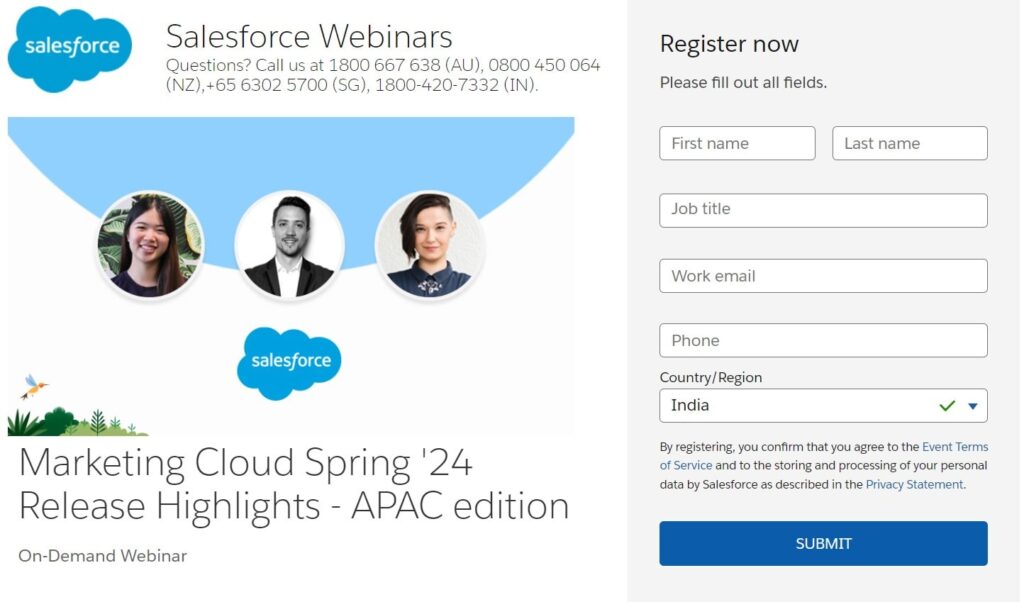
Image via Salesforce
Use Website Content to Boost Signups
Lead generation isn’t always a straight line. Sometimes, you need to weave your website visitors into your corporate culture and brand through a more complicated route.
Website content, such as blog posts, can help boost webinar signups. At that point, you’ve collected a lead and increased your chances of interacting with the lead.
Include a link to your webinar in your blog post CTAs. Later, after the webinar is over, change the CTA to something else so you don’t lose potential leads.
Alternatively, you can run webinars over and over again. In this case, you don’t have to change your CTA as long as the signup URL remains the same.
Plan Webinars in Advance
People often sign up several weeks before a webinar, and if you want to boost attendance rates, you need a long promotional cycle. Start promoting your webinar well in advance, then send sequential emails to remind your registrants about the event.
Tips for Webinar Lead Generation
You can do several things to increase your lead-generation results through webinars:
- Always ask for email addresses during the signup stage.
- Keep a list of people who signed up and did not attend, then send them emails about a subsequent webinar.
- Remind registrants they signed up during later emails to boost brand loyalty.
- Include an immediate download or other lead magnet with your webinar sign-up process.
- Create webinars that are at least 40 minutes long.
- Test different days and times to figure out the ideal timing for your audience.
Don’t forget about promoting your webinar. A Hello Bar can increase webinar signups, so consider creating one to launch about a month before your webinar’s air date.
If you follow those tips, you can maximize your lead-generation efforts and make your webinars more successful.
4. Use Google or Facebook as Your Website Login
People are tired of creating new accounts for every website, especially ecommerce sites. Filling out all those fields is time-consuming, and forgotten passwords have become a daily frustration for many consumers.
Lead generation is all about overcoming barriers and objections. A signup form or lead-capture form for your website is a significant objection
You can overcome it by allowing people to log into your website using their Google or Facebook accounts or by making it possible to connect to their password manager, which will automatically fill in the details. If you offer both, you’ll please even more of your prospects and generate more leads.
Check out how Medium, a popular blogging platform, offers multiple easy signup options to site visitors. By making signing up easy, it gets more users for its platform and you can do the same.
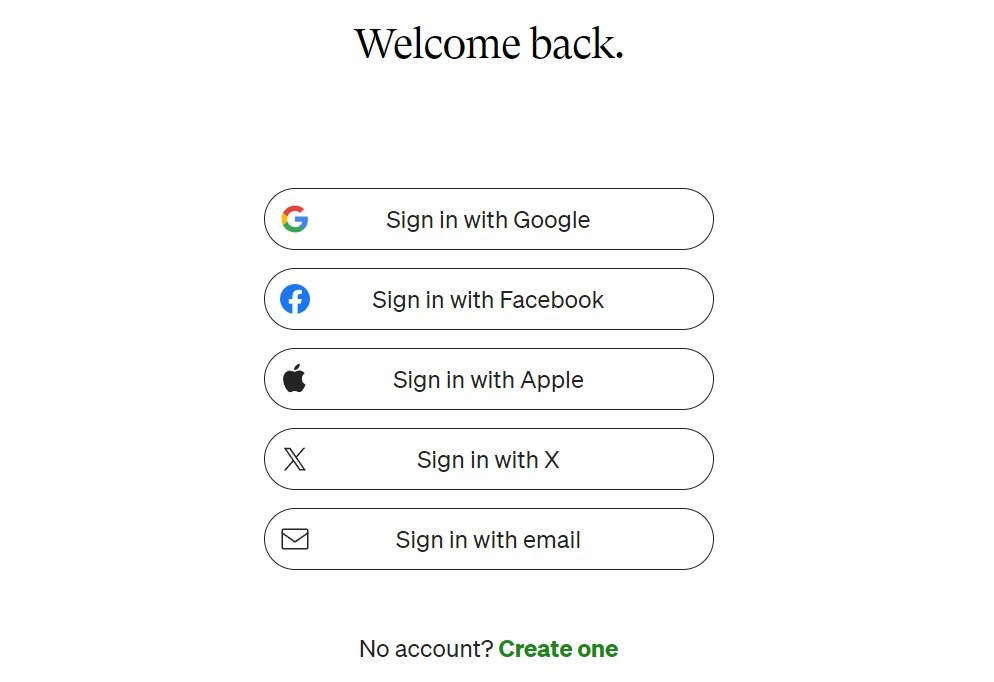
Image via Medium
5. Use Strong Verbs to Write Powerful Headlines
Your headlines help convey value to your audience. Many people won’t read beyond the headline at all, especially if it’s not sufficiently compelling.
The best headlines combine SEO and clickbait. You want to entice both search engines and people, so include keywords related to the page’s topic along with something juicy for readers.
Powerful verbs automatically give more gravitas and interest to headlines. For instance, in the headline for this article, we decided to use the word “boost” instead of “increase” because it’s more powerful and interesting.
Here’s another example of a blog post on our website. Instead of using boring words like “increase,” we used “skyrocket” to emphasize that users will get a lot of value from the best practices listed in the article. This is a great way to get more leads from blog posts.
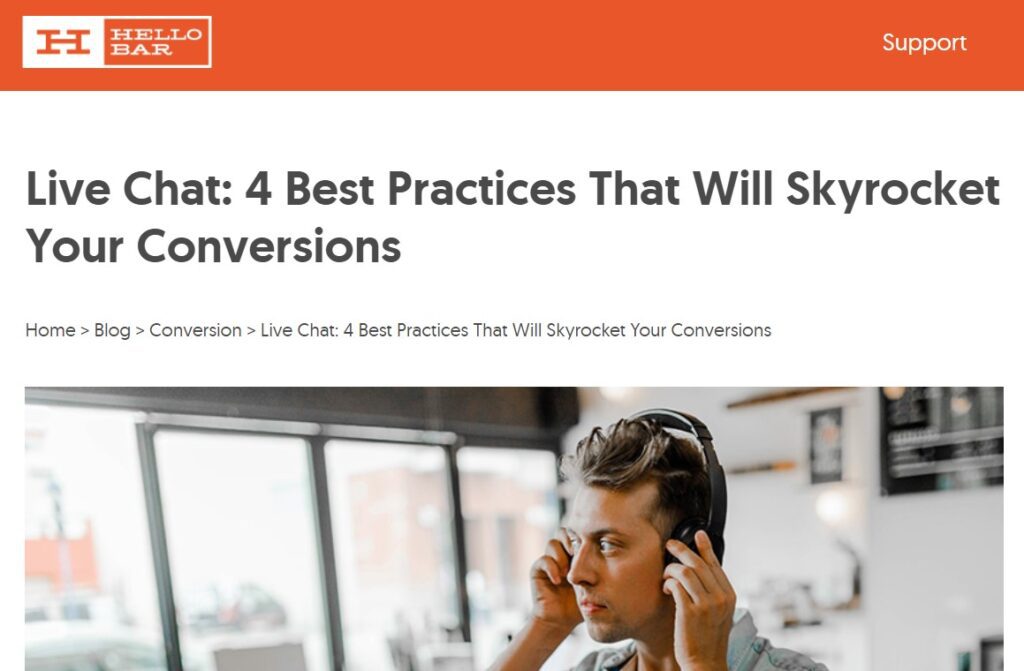
Image via Hello Bar
Many strong verbs exist, so grab your thesaurus. When you use a verb in a headline, make sure it’s the right one for your audience.
6. Create Irresistible Lead-Generation Offers
A lead magnet is designed to incentivize signups or other desired actions. Without a lead magnet, your audience doesn’t have any reason to take you up on your offer.
Lead magnets come in lots of shapes and sizes. Many businesses offer e-books, checklists, whitepapers, or free online courses as thank-yous for signing up. However, you can get as creative as you like.
The important thing is to create an irresistible offer for your audience. In other words, what do your specific leads want most?
If you’re marketing to people who don’t like reading, an e-book becomes a waste of time as a lead magnet. You could offer a video or audio recording instead.
Other potential lead magnets include webinar replays, calculators, cheat sheets, PowerPoint timeline templates, and case studies. You can decide what will most delight your audience.
Check out how AppSumo encourages people to sign up for its newsletter by offering a 10% discount on their first order.
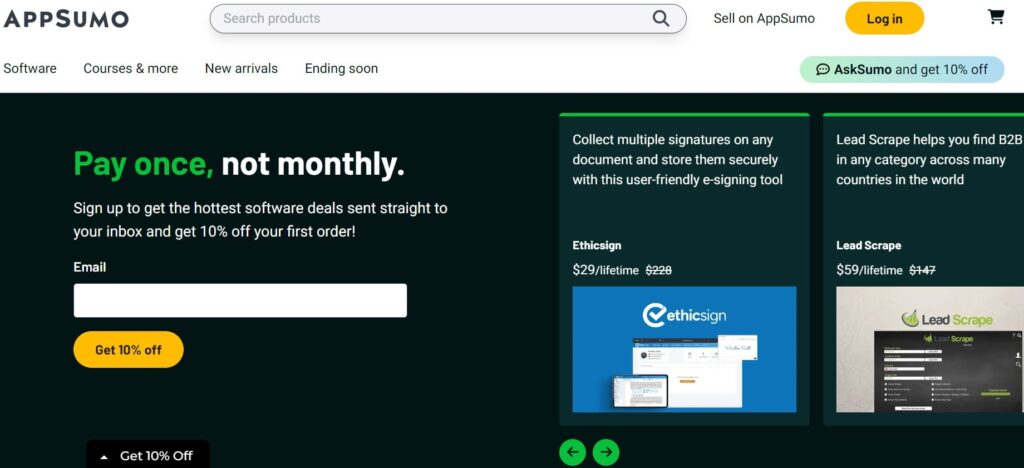
Image via AppSumo
You can replicate this lead generation strategy by offering an incentive that your target audience will find valuable.
7. Don’t Neglect Social Media for Lead Generation
Social media can play a huge role in your lead-generation efforts. It’s designed for interaction, so every time you respond to a comment, like a prospect’s post, or otherwise engage with your audience, you’re laying the foundation for a future relationship.
Here are some ways you can use social media for lead generation.
- Link to your lead magnets from your social accounts using a compelling CTA. Focus on what’s in it for your audience.
- Hold contests and giveaways. These events are great for lead generation because they instill desire in your prospects. If they participate in the contest, they want the prize. Those who don’t win might buy instead. Create rules for participation that help you gain more followers and generate leads.
Check out this Instagram giveaway that asks participants to follow the page and tag 3 friends. This attracts not one, but four potential leads to the host’s social media account.

Image via Instagram
- Go live using the live streaming option on various social platforms, including Facebook and Instagram. When you “go live” for your audience, you’re seen as more transparent and trustworthy. Use the opportunity to ask your audience to check out your website or direct them to a landing page from where you can capture leads.
Just remember that social media might seem like nothing more than a fun place to hang out, but people still want value. If your tweet, Facebook post, or other social media content doesn’t offer anything valuable, resist publishing it.
8. Share Content on LinkedIn
LinkedIn has a publishing platform, which allows you to publish original content for your LinkedIn followers to read. It’s also a fantastic lead-generation tool.
You have several options when deciding how to use it.
The first is arguably the easiest. Publish a new article on LinkedIn every time you publish a new blog post. Simply copy and paste the introduction into the LinkedIn publishing system, then add the words “Continue Reading” to the end. Using “Continue Reading” as anchor text, include a link to the full blog post on your website.
Alternatively, you can create original content for LinkedIn. This takes more time and effort, but it can help you build authority.
Whether you republish whole blog posts or create original content for LinkedIn, always include a link in your CTA. It can go to the full blog post, as described above, or you can link to a landing page to collect email addresses.
Amazon Web Services (AWS), for instance, often shares excerpts from its latest articles on LinkedIn and adds a link to the original article. It also mentions the reading time in its posts to inform readers of the time commitment they need to read the article.
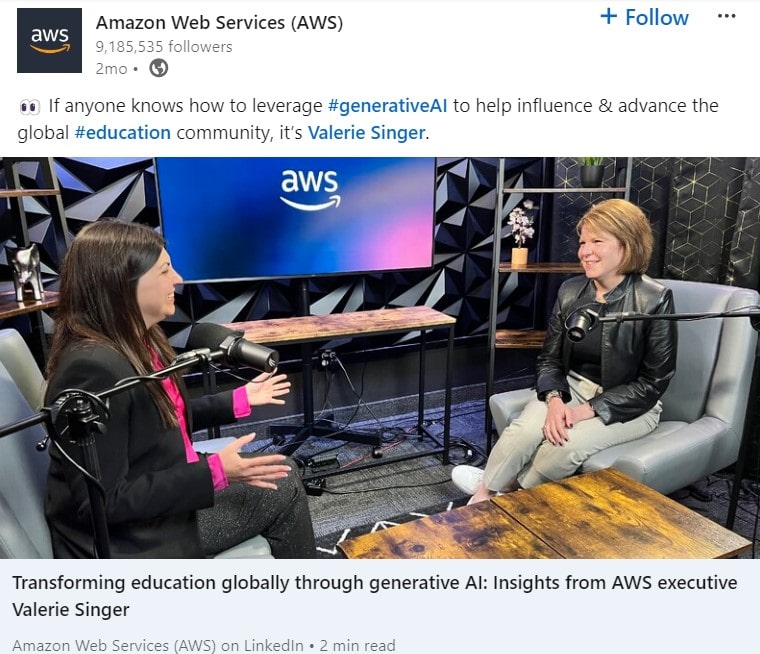
Image via LinkedIn
9. Create Strategic Partnerships to Generate New Leads
Partnering with other business owners can improve your lead-generation efforts. You gain access to each other’s audiences, which benefits you both.
Look for partners within your industry who aren’t competitors. For instance, if you sell footwear, you could partner with a fashion company that sells other clothing.
Cross-promote each other’s content, link to one another in your blog posts, and host shared contests or giveaways. You’ll both maximize your lead generation and build more brand awareness.
10. Employ Exit-Intent Popups
An exit-intent popup is triggered when a website visitor moves his or her cursor close to the button for closing a browser or browser tab.
Essentially, exit-intent popups provide a last-ditch effort to capture your lead. Most of these popups include some special offer or discount code to entice a visitor to provide an email address or buy a product.
You can easily create attractive exit-intent popups on Hello Bar.
Here’s a simple exit-intent popup template by Hello Bar that you can use to create popups that generate leads. It’s completely customizable, so you can modify the image, copy, and CTA to make it work for your target audience.
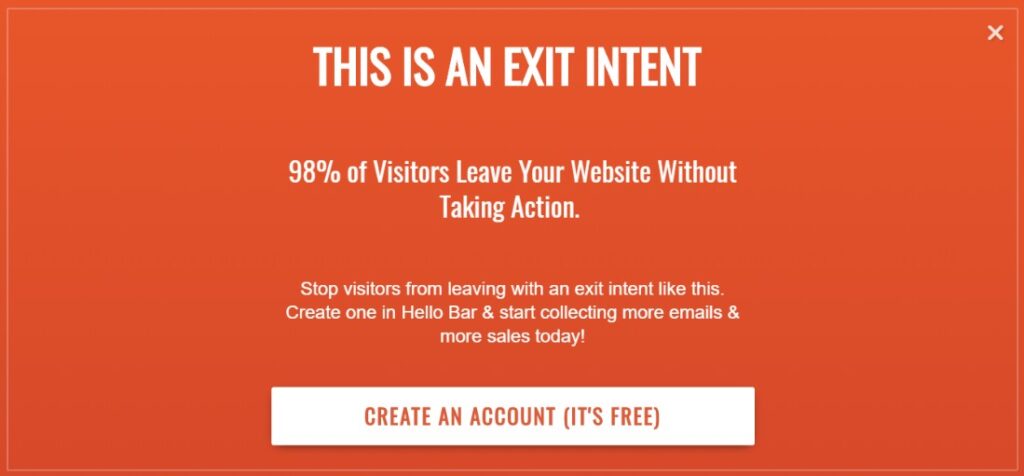
Image via Hello Bar
11. Run a Referral Program
There’s no one better to promote your business than your existing customers. All you need to do is provide them an incentive to do so.
That’s where referral programs are useful. Create a referral program for your loyal customers and offer lucrative incentives for them to refer your brand, product, or service to their family and friends.
You could offer a discount to both the referrer and the leads they bring in. You can also create a gamified loyalty program where customers earn points for each desired action, such as referring your brand to a new potential customer.
Dropbox, for example, offers free storage to the referrer and the person who joins as a result of the referral. This incentivizes both to use the referral code.
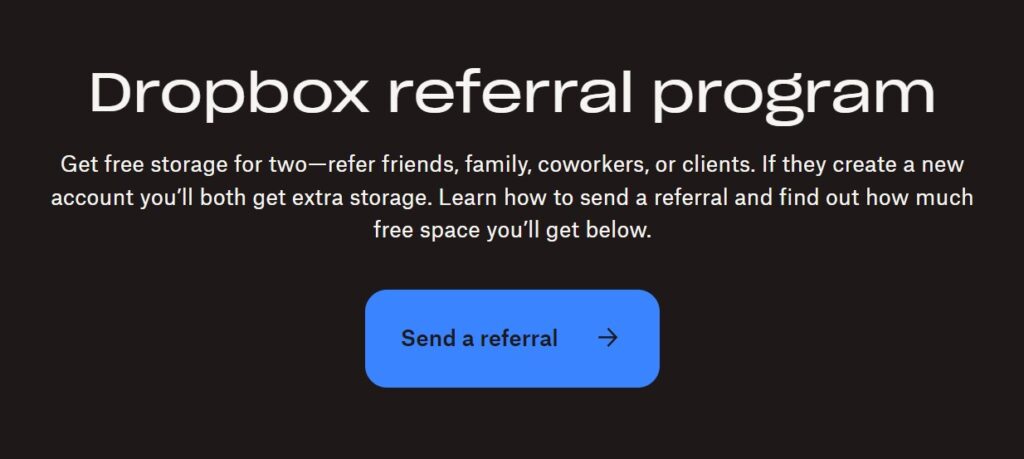
Image via Dropbox
12. Offer a Free Trial
If you have a SaaS product, then offering free trials is one of the best B2B lead-generation strategies for your business. People love to try a product before they commit to a subscription plan and a free allows them to do that.
To further sweeten the deal, avoid asking for users’ credit card information to sign up for the trial. This will remove any hesitation they may have regarding data security and make them more likely to try your SaaS product.
Each individual who signs up for a free trial is a lead for your business. You can then create a lead nurturing strategy that involves sending emails with exclusive discounts and offers to upgrade to a paid plan.
13. Use the Best Software to Maximize Your Lead-Generation Efforts
Automation is the name of the game when it comes to lead generation. Now that we have many tools available to use for automating lead gen, how do you know which to choose?
The best software programs offer flexibility, ease of use, and effectiveness. Hello Bar is one of the best available.
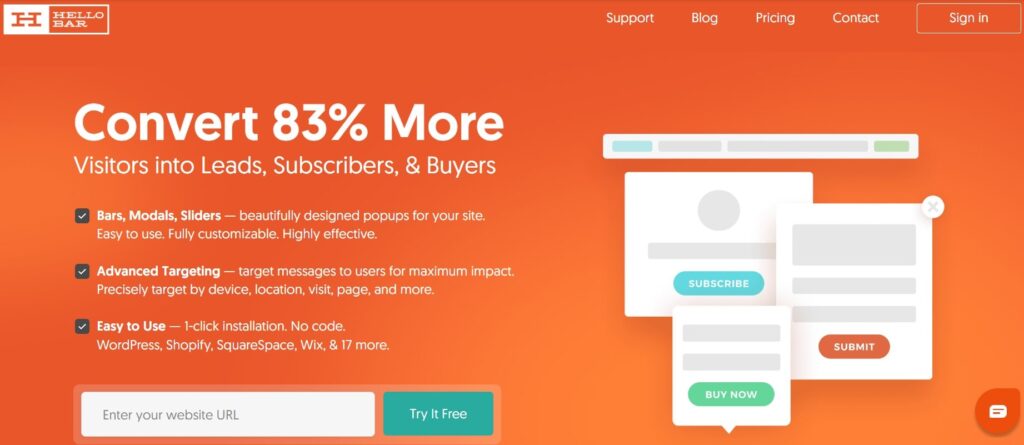
Image via Hello Bar
You can use Hello Bar to capture leads, A/B test your offers, and much more. Plus, you’ll get sophisticated data to help you design campaigns in the future.
Use Hello Bar with automation tools like MailChimp that help your sales team nurture leads and drive them down your sales pipeline. Staying in communication with your prospects helps you build brand loyalty and boost customer retention.
FAQ
1. What is lead generation?
Lead generation is the process through which businesses find and capture information on prospective customers. A lead is someone who has shown interest in a business or its product or service.
Businesses use various lead-generation strategies to attract their target customers and nudge them to enter their marketing or sales funnels.
2. What is an example of lead generation?
Let’s say a user sees a Facebook ad promoting an online event or webinar. They click on the link and reach a landing page on your website, from where they sign up for the event. The moment they provide their information and register, they become a lead.
Lead generation is not about driving sales, but introducing new consumers to your brand or offerings. They may or may not buy from you or take any desired action.
3. Why is lead generation important?
Lead generation is a top-of-the-funnel marketing tactic that helps prospective customers discover your brand and its offerings.
It’s the first step in the process of winning new customers for your business. Without successful lead generation, you won’t be able to bring in new customers for your business.
4. What are the steps in the lead-generation process?
Here are the typical steps involved in the lead generation process:
- A consumer discovers your brand or content on one of your marketing channels. This could be an ad, a blog post, social media content, etc.
- They engage with your brand or content and click on a call to action link.
- They visit a landing page on your website, which is designed specifically for capturing lead information.
- They fill out a form, usually to get some incentive, and provide their contact information.
- Voila! You have now generated a lead for your business.
Note that leads generated via marketing efforts are called marketing-qualified leads. The leads brought in by sales teams, on the other hand, are called sales-qualified leads.
Once the process of generating leads is over, the next steps involve lead scoring and nurturing.
5. How can I generate leads fast?
Here are some online lead-generation strategies that can help you with generating high-quality leads quickly:
- Lead magnets: Offer free content or any other valuable resource in exchange for your site visitors’ email addresses.
- Contests and giveaways: Run contests on social media or your website and ask people to provide their email addresses to participate.
- Webinars and events: Host a webinar or industry event that your target audience will be interested in. Ask for their email addresses for registration for the event.
- Free trials: Offer a free trial of your software solution to encourage more people to make an account. Promote the free trial strategically on your website and on other platforms you use.
While all the lead generation hacks mentioned above are effective, these will drive results quicker.
6. What are the best strategies for lead generation?
Here are some of the top lead-generation strategies that you can use:
- Create high-quality content
- Optimize your website for lead generation and conversions
- Host a webinar
- Use Google or Facebook as your website login
- Use strong verbs to write powerful headlines
- Create irresistible lead-generation offers
- Use social media for lead generation
- Share content on LinkedIn
- Create strategic partnerships to generate new leads
- Employ exit-intent popups
- Run a referral program
- Offer a free trial
- Use the best lead generation software to get the best results
7. What are the best practices for effective lead generation?
Here are some online lead-generation best practices you should follow:
- Understand your audience and tailor your lead-generation efforts to them
- Use conversion rate optimization (CRO) to create high-converting landing pages and signup forms
- Create a lead-generation funnel utilizing multiple tactics to get the best results
- Focus on personalization and relevance in your marketing and lead-generation efforts
- Always track the performance of various tactics and keep optimizing your lead-generation process
8. What are the common mistakes to avoid in lead generation?
Here are some things you must avoid in your online lead-generation campaign:
- Making your signup forms long and tedious could lose you many valuable leads, so avoid that. Keep your forms short and simple.
- One common mistake marketers make is not providing offers that are lucrative enough to turn people into leads. Your lead magnets will not be effective if you don’t offer enough value.
- Lastly, using poorly-designed landing pages is one of the biggest mistakes you can make. All your lead-generation efforts will be pointless if you lose potential leads due to low-quality landing pages.
Conclusion
What is lead generation? It’s the process of acquiring access to potential customers. You can use automated lead-generation tools to collect leads faster and more efficiently.
If you’re struggling with lead generation, focus on deploying our 13 fast and simple tips.
Focus on content and optimize every page of your website for lead generation and conversion. You can host webinars, create lead magnets, publish on LinkedIn, and partner with other businesses in your industry.
Consider allowing people to log into your website using Google, Facebook, or both. You’ll eliminate a common objection.
Strong headlines with powerful verbs can help keep prospects on the page longer, and exit-intent popups allow you to present visitors with a final offer for conversion. If you’re using Hello Bar, you can create one in just a couple of minutes.
What’s your favorite lead-generation hack? Comment below!



